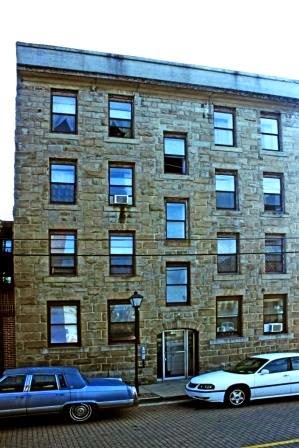~~~~~~~~~~~~
Phenix Bridge - Milepost 158
Sponsored by Charlotte & Aubrey Wiley
Just
after midnight, December 2, 1957, Virginian’s eastbound time freight
number 72 derailed off Cub Creek
Bridge in Charlotte County, Virginia, just west of Phenix. Thirty eight cars of the fifty one car train sailed off the south side
of the bridge. Miraculously, five freight
cars and the caboose came to a stop just short of falling from the bridge. The repaired bridge was back in operation in
just under thirteen days. Several of the bridge legs were destroyed as part
of the bridge itself fell to stream below.
 |
| Greg Elam Picture |
The wreck site can be seen from the south sie of route 40, one mile west of downtown Phenix. There is space to park off the roadway. It is on private property but the owner allows respectful visitors who are studying the Virginian Railway Heritage Trail.
~~~~~~~~~~~~
Brookneal, Va. - Milepost 170.3
Sponsored by Ed Burnett
 |
| Herman Ginther Picture, A. Wiley Collection |
In its prime, Brookneal had a station on the south side of the railroad and a freight house stood beside a house track on the opposite side with a passing siding between. The railroad structures were always painted in the early color scheme of orange with white trim. The west end of the surviving freight house is shown behind the flat car loaded with farm tractors.
 |
| Aubrey Wiley Picture |
The station was razed circa 1958, replaced by
a small, gray agent-operator’s shanty, 12 by 24 feet.
Aubrey Wiley Collection
In this 1950 picture, train number 3 passes the freight house as it approaches the Brookneal station. Notice the small dark object on the ground in bottom center. It is the flap cover for the withdrawn Robertson High Speed Train Order device, which is extended in the top picture.
 |
| Aubrey Wiley Picture |
The freight house was purchased by Foster
Fuels from N&W after the merger and has been well cared for ever since. Today
the VGN Freight House is painted “Barn Red” and is on Old Main Street, of 501
south of downtown, but north of the Staunton River Bridge. The VGN Freight
House is privately owned but visitors are allowed. The structure stands beside the old Virginian
and today it is a very active NS line. Do not trespass near or on the railroad
tracks!
~~~~~~~~~~~~~~
Altavista, Va. Staunton River Bridge - Milepost 200
Sponsored by the Town of Altavista
The town of Altavista, Virginia and the Virginian station are at milepost 199.2. When H.H.Rogers' Tidewater Railroad was bieng constructed a major contractor was an Altavista company run by the English family. In addition to the projected business growth that was projected, there would be a connection and interchange with the Southern Railroad's north-south mainline. In April 1909 after the Rogers' celebration and inspection train reached Altavista, a grand dinner was held. Rogers enjoyed himself so much that he delayed the departure of his train until the following day. That delighted the Altavista hosts but in Roanoke, the city's leaders had planned a grand celebration in N&W's Hotel Roanoke! Hurt feelings were healed and it all went of without a hitch, just one day later.
 |
| H. Reid Picture, A.Wiley Collection |
 Altavista,
Va., may be reached from the east by route 699, Gladys Rd., and from the north and south by US route 29.
The Virginian Heritage Trail sites are all in the downtown area. Enter town on
Main Street and turn east on Pittsylvania Ave. to reach English Park. Travel about 200 yards on Pittsylvania Ave.
and then turn right onto Third Street. The park is straight ahead. Park near the pavilion or drive a little further
and park. To reach the Virginian’s bridge at milepost 200 over the Staunton
River, visitors may walk along the trail for about 15 minutes or bike for about
5 minutes. Walk or bike on the paved
trail bearing to the right which goes under the old Southern Railway bridge
over the Staunton River. The vintage picture above was made from the opposite side of the river while the train's freight cars are shown above the location of the English Park Trail.
Altavista,
Va., may be reached from the east by route 699, Gladys Rd., and from the north and south by US route 29.
The Virginian Heritage Trail sites are all in the downtown area. Enter town on
Main Street and turn east on Pittsylvania Ave. to reach English Park. Travel about 200 yards on Pittsylvania Ave.
and then turn right onto Third Street. The park is straight ahead. Park near the pavilion or drive a little further
and park. To reach the Virginian’s bridge at milepost 200 over the Staunton
River, visitors may walk along the trail for about 15 minutes or bike for about
5 minutes. Walk or bike on the paved
trail bearing to the right which goes under the old Southern Railway bridge
over the Staunton River. The vintage picture above was made from the opposite side of the river while the train's freight cars are shown above the location of the English Park Trail.
When
visitors return to the parking lot, the large pedestrian walkway over the old
Virginian offers a good picture location for both east and west bound trains. At the north end of that pedestrian walkway,
the old brick Virginian station can be seen. A fire destroyed the VGN wood
station in the fall of 1957. Today, it
is a very active business center for Norfolk Southern. Do not trespass. This
structure can also be seen well from the end of South Broad Street, off Main Street.
 |
| A.Wiley six pictures |
Altavista, Va. Caboose 344 - Milepost 199
Sponsored by the Town of Altavista
 To
see the Virginian caboose 344, from Main Street, travel two blocks north on
Broad Street, turning left at the library. Go two more blocks on Washington
Street to see the restored Southern Railway station which now houses the local
Chamber of Commerce. Beside the station is the VGN caboose.
To
see the Virginian caboose 344, from Main Street, travel two blocks north on
Broad Street, turning left at the library. Go two more blocks on Washington
Street to see the restored Southern Railway station which now houses the local
Chamber of Commerce. Beside the station is the VGN caboose.
~~~~~~~~~~~~
Roanoke, Va. - Milepost 243.1
Sponsored by the Virginia Museum of Transportation
Virginia
Museum of Transportation - Located on Norfolk Avenue in downtown Roanoke is the
Virginia Museum of Transportation. It can be reached from Salem Avenue by
turning north onto Third Street. The museum is straight ahead. The hours are from 10:00 am to 5:00 pm daily
except for 1:00 pm to 5:00 pm on Sunday.
VMT is well known for its variety of transportation items and quality of presentation. Several
pieces of equipment used on the Virginian Railway are preserved and displayed
here.
·
Virginian
Steam Locomotive number 4 was built
by Baldwin Locomotive Works, August
1910. The Four Spot saw use as a yard engine all over the railroad before being retired in 1957.
Primarily it was used at Sewalls Point, in Norfolk, Suffolk, Victoria ,
Roanoke and Princeton’s yards.
·
Producing
3, 300 horsepower, Virginian Electric Locomotive number 135 was built by General Electric in November
1956. Virginian’s electrified territory
reached from Mullens, WV to Roanoke,
Va., a distance of 134 miles.
·
Virginian
caboose number 321 is classed C-10 and was built by St. Louis Car Co. for the
Virginian in 1949. Serving all over the
entire railroad of nearly 600 miles in length, a freight train’s crew called it
home while in transit. The train’s caboose crew could consist of as many as
five men. Cabooses were typically
assigned to a specific conductor who would often personalize his caboose. It was equipped with a propane stove for
cooking and heat, electric lights, drinking water and a toilet.
·
Virginian
Agent/Operator’s shanty from Ellett, Va, milepost 272.4 was built in 1952 by
railroad forces of “available materials,” rough cut oak. This structure replaced a traditional
station at that location.
·
The
Virginian Room displays many interesting Virginian items from private
collections.
·
Other
railroad pieces include N&W’s class J locomotive 611 and class A 1218.
~~~~~~~~~~~~~
Roanoke Passenger Station - Milepost 243.1
Sponsored by C. E. Salmon and the Roanoke Chapter National Railway Historical Society
Jeff Sanders Picture
Virginian
Passenger Station – Located beside the old Virginian mainline at the
intersection of South Jefferson Street and Williamson Road, SE. is the
Virginian passenger station built in 1909. It is said to be constructed from a
New York Central Railroad standard plan. The structure is owned by Roanoke Chapter NRHS.
~~~~~~~~~~~~~
Walnut Avenue Tower - Milepost 243.1
Walnut
Avenue Tower – About 100 yards east of the passenger station is Walnut Avenue
Tower built to protect the VGN’s crossing with Norfolk & Western’s Winston
Salem line. The bridge overhead is Walnut Avenue, hence the name. It is owned and used by Norfolk Southern. Do not trespass on the
railroad.
~~~~~~~~~~~~~~~~~~~
Merrimac - Milepost 278.3
Sponsored by the Montgomery County Dept. of Parks & Recreation
 |
Harry Bundy Picture
|
Merrimac operator’s shanty was located on the north side of Virginian right of way at milepost 278.3 and just over a hundred yards west of the west portal of Alleghany Tunnel, 5176 feet long. Between these two features, a bridge carried N&W’s Huckleberry Branch over the Virginian, linking Blacksburg and Christiansburg, Va. A connecting track between the two railroads was near the operator’s shanty.
To reach Merrimac, the traveler may use a paved trail, that was part of the above mentioned N&W branchline, created and maintained by Montgomery County. “The Huckleberry Trail” starts behind the left (south) end of New River Valley Shopping Mall. Enter the Mall by turning off business 460 onto Radford Road and enter the mall parking lot. Turn to the far left (south) end where a roadway loops behind the mall. Signs for the trail and a parking area are very visible in the back of the mall. The distance to Merrimac is about ¾ of a mile, 5 minutes on a bike or 15 minutes by walking. The trail crosses the former Virginian mainline which is now a very active NS mainline. When on the bridge over the railroad, look to the west for the site of the operator’s shanty and look to the east for the west portal of Alleghany Tunnel. About one mile beyond Merrimac is the county’s Coal Mining Heritage Park where anthracite coal was once mined.


The tunnel was 5176 feet long with the crest of grades being at the west portal, 1960 feet above sea level. The grade for westbound trains approaching the tunnel was 1.5% while .6% was the grade for eastbound trains approaching the tunnel. The tunnel was improved with concrete lining and portals in 1924.
~~~~~~~~~~~~~~~~
Narrows Power Plant - Milepost 317.4

Sponsored by the Town of Narrows

As the coal traffic on the Virginian began to mushroom by 1920, it became clear a better solution had to be found to get the loaded coal trains out of West Virginia. The grade at Clark’s Gap, west of Princeton, was the steepest and a bottleneck to operations. And it was expensive to operate in its then-current condition. Huge steam locomotives were being used and the trains were slow. At the railroad’s Board of Directors meeting in the spring of 1923, it was decided to commence work to electrify a portion of the railroad. Engineering and design work commenced Nov. 29, 1923 after Virginian’s hiring of the engineering firm of Gibbs & Hill of New York City, generally identified as pioneers in railroad electrification. One hundred and thirty four miles of the mainline would be electrified. The firm immediately erected a field office at Narrows before construction of the power plant started. To construct the overhead and functioning electric lines for the 133.6 miles of electrified railroad, the railroad directors approved $5,964,973 for catenary in Virginia and $1,977.292 for catenary in West Virginia.

Geo K. Shands Picture, William Clemons Collection
Narrows, Virginia was chosen as the site for the power plant because of a town already there and it being half way between the extreme ends of the electrified territory; Mullens and Roanoke. The plant’s primary building was 220 feet by 156 feet and roughly 140 feet high. Two brick stacks stood 376 feet tall. There were three turbo generators with a fourth available as needed, each capable of producing 15,000 k.w of electricity. By means of transformers, the power could be raised to 88,000 volts when it left the plant. The 377 transmission towers, arranged along in more or less straight lines but not necessarily adjacent to the railroad, carried two 88,000 volt circuits. Seven step-down transformer stations were located at Elmore, Clark’s Gap, Princeton, Narrows, Eggleston, Merrimac and Wabun. The 88,000 volts current from the transmission lines was dropped down to either 11,000 volts or 22,000 volts to be supplied as needed to the trolley lines directly above the tracks for the electric locomotives.
As an illustration of the output of the Narrows Power Plant operation, the 45,000 kilowatts to 60,000 kw produced at the plant in 1925, before any upgrades or modifications, would be sufficient to power the entire City of Princeton, West Virginia in 2010. (sources - 2010 US census and Appalachian Power Company)

For its initial electric locomotives, the railroad turned to Alco and Westinghouse; Westinghouse specialized in AC transmission whereas at the time, General Electric preferred DC transmission. While rather simple looking in outward appearance, these three section locomotives could provide tremendous amounts of power, 7,125 hp and 231,000 pounds of tractive effort. The locomotive’s tremendous tractive effort was in part due to its large size, weighing in at over 1.2 million pounds with a length of 152 feet and 3 inches. Initially, Virginian received and operated twelve of these three section locomotives, spending $4,646,292. Within a few years, the last one was divided into three single section locomotives for switching and yard work. During the years of their lifespans, a couple others were separated and then reunited again. Virginian added more electric locomotives of different designs in 1948 and 1956-57.
After Virginian’s merger with N&W December 1, 1959, N&W made a token effort to utilize the Virginian’s electric locomotive fleet. The electrics didn’t fit in; they could only be used on a section of the former Virginian line and N&W had cast its lot into the diesel electric locomotive camp earlier. In June 1962, the last train to operate over the old Virginian with electric locomotives made its last run into Roanoke. The engines were a trio of five years old General Electric, 3300 horsepower, class EL-C class locomotives. With no purpose to serve, the Narrows Power Plant was demolished in 1970.
~~~~~~~~~~~~~~~~
Glyn Lyn Bridge - Milepost 323.4
Sponsored by the Town of Glen Lyn
 |
| Greg Elam Collection |
Vintage
newspaper stories date the completion of the last piece of Virginian railroad
as being at the west end of New River Bridge at Glen Lyn, Va. on January 23,
1909. The author of one newspaper story
reported that the weather was “so cold an Eskimo would freeze.” The bridge was
2155 feet long and about 130 feet above the New River, depending on the water
level.
 |
| Steve Summers Picture |
In 1972, after the merger with
Norfolk & Western on December 1, 1959, N&W took this area out of
service and sold a section of the Virginian right of way to the Virginia
Highway Department for a new eastbound lane for route 460.
On
January 23, 2009, about a dozen hearty Virginian fans and historians gathered
at Princeton and Glen Lyn to observe the centennial of the completion of the railroad.
And on that date in 2009, the weather duplicated the conditions of 1909!
~~~~~~~~~~~~~~~~~~
Princeton, WV - Milepost 340.2
Sponsored by Princeton Railroad Museum
 |
| Delbert WHitlow Picture |
 |
Kurt Reisweber Collection
The
Princeton, WV station, built in 1912, was one of only two, two-story stations
constructed on the Virginian. The other was at Victoria, milepost 119.7, and
both housed division offices upstairs. This vintage, hand colored post card
shows the side often seen by the public as they approached the station to meet
a passenger train. N&W demolished the original building in 1979.
The City of Princeton
built a replica station in 2006, while developing the adjacent neighborhood
into an historical center. The structure, although not painted in authentic
Virginian colors, houses an excellent collection of Virginian artifacts with meeting rooms for social functions. The hours vary so calling is
suggested. 304.487.5060. It is
located on the site of the original station, 99 Mercer Street. The original freight house is next door.
~~~~~~~~~~~~~~~~~~~~~~
|
Elmore Yard - Milepost 374.7
Approaching
Elmore from Princeton on route 10, be alert for several often photographed
locations along the way. As crossing a large concrete bridge, be aware of the
NS railroad facilities below. The old Virginian mainline from Princeton curves
in from the east while the Guyandotte River branch passes under the bridge. Virginian’s steam engine servicing facilities
were in the area to the east of the north end of the bridge. Turn right onto route 16 to reach Mullens.
 |
Tom Marshall Picture
In
the recent picture above, the NS locomotive is passing form the westbound
mainline onto the Guyandotte River branch to the left. All three legs of a wye are
visible in this picture with the westbound mainline being behind the brick
railroad office structure. The track with standing camp cars is the leg
connecting the eastbound mainline to the Guyandotte River branch. The two miles
long Elmore Yard is in the narrow river valley in the top center
~~~~~~~~~~
Mullens – Milepost 376.7
Sponsored by Tom Marshall
Located
at the north end of Elmore Yard is Mullens and the site of the famed “Motor
Barn” where from 1925 through the N&W merger to the summer of 1962, all
electric locomotives were shopped. When diesels started to arrive in the spring
of 1954, they were maintained at Mullens Motor Barn as well. In 2011, the structure was demolished. The famed Winding Gulf branch enters the mainline
at Gulf Junction, beside the site of the motor barn.
Tom Marshall Picture
Tom Marshall Picture
In
2011-2012, a replica of the Virginian’s Ellett agent-operator’s shanty at Ellett
was built in Mullens to serve as a
railroader’s museum. It stands in front of the Mullens Opportunity Center (formerly Mullens Grade School) on Guyandot
Road.
VGN
caboose 307, class C-10, built by St. Louis Car Company in 1948, is preserved
and sits near the Rite Aid Pharmacy at
301 Moran Avenue in the north end of the downtown business district.
~~~~~~~~~~~~~~~~~
Slab
Fork – Milepost 387.9

Sponsored by William H. Johnson III
Opening in 1907, Slab Fork was the first coal mine in the Winding Gulf Coal Field. Initially coal was mined from the Beckley seam but later, mine shafts reached the seam of Pocahontas 3 & 4 coal. A trade publication of 1917 reported the company town of Slab Fork hosting over 200 houses for miners and five more for mine officials. Among its amenities were a movie theater, churches, school which operated eight months of the year. The coal company provided land for light farming and teams for preparing it for cultivation.
Ghislain Gerhard Picture
Soaring
above the town is Virginian’s massive bridge, 613 feet long and eighty feet
high. Slab Fork is very representative
of the area’s coal mining communities and is easily reached from Mullens by
traveling north on route 54.
~~~~~~~~~~~~~
Oak Hill Station - Milepost 419.3
The
Virginian Oak Hill Station does not resemble other Virginian structures for a
very good reason. It was built in 1903 by the White Oak Railway, the railroad
facility of owner White Oak Coal Company and the Virginian may not have even
been an idea in 1903. Virginian leased the station in 1912 and ultimately purchased
it 1922. After the VGN/N&W merger of 1959, N&W continued to use the
facility until closure in 1983. It was
donated to the City of Oak Hill by Norfolk Southern in 1995.
The
station, located at the corner of Virginia and Central avenues in Oak Hill, WV,
is owned by the city and used by the White Oak Chapter of the National Railway
Historical Society. It is painted in
Virginian’s standard color scheme of orange with white trim which was used from
the inception of the railroad to 1945.
~~~~~~~~~~~~~
The Deepwater Building, Beckley, WV
Served by means of trackage rights over C&O Ry.

Sponsored by John Zuro
Tom Marshall Picture
Heather Reynolds Picture
The Deepwater Building, standing in historic downtown Beckley, West Virginia at 128 S. Heber Street, was built circa 1904 by the Deepwater Railroad to be the headquarters of the coal sales office of Loop Creek Colliery of Page and Beards Fork, WV. H.H. Rogers was a primary owner of both the Deepwater Railway, which became the Virginian Railway in April 1907, and Loop Creek Colliery so the connection is obvious. In 1910 a devastating fire consumed nearly all of downtown Beckley, save the stone, four story Deepwater Building. In 1912 the Virginian Railway sold the structure to a partnership of two Beckley men, a lawyer and a doctor, who rented out the unused professional space to others, including the American Red Cross and the Citizens Bank of Beckley. In 1919 a fire destroyed some of the interior of the structure. In 1920, the partnership in turn sold the building to the United Mine Workers Union to serve at headquarters of Distract 29. In the building's second century of life, it offers residential apartments.
~~~~~~~~~~~~~~~~~
Page - Kincaid - Milepost 426.8

Sponsored by Doug Bess
This 1906 view shows much of Page under construction. At the top, the station is being built and in the upper left, the branch to a coal mine is being graded. Greg Elam Collection
Page, West Virginia was named for William. N. Page, a civil engineer whose idea it was to buy a logging railroad and extend it south from the Kanawha River to untapped coal deposits. He convinced H.H. Rogers of the validity of his idea and thus, the two men began what would become the Virginian Railway. C.H. Slayton, Jr, in his book “Virginian Railway Early Years,” states that Page was the operating headquarters for the Deepwater Railroad, 1905-1906. Page was also the headquarters of the Loup Creek Colliery Company which built a company store and a library. Page was a medium sized marshalling yard located just 8.2 miles from the very end of the railroad at DB tower. There was a wooden three track engine house with a back shop attached on the compass west side. When Princeton received a new 120 foot long turntable in 1919, the old 100 footer was strengthened and moved to Page. In 1939, it was removed and replaced by a wye on which locomotives would be turned. The old 100 foot turntable saw another life as a highway bridge at Oceana.

In 1967, Doug Bess took this pitcure looking eastbound on the former VGN mainline.
By 1990 all coal mining at Page had ceased and the countryside began to revert back to nature. However, there was still coal to be mined and in 2007 Frazier Mining Company constructed a flood loading facility, using a system of conveyors to bring in coal from two sources; a mountain top strip mine as well as from a deep mine. By flood loading, entire trains of empty hoppers are loaded while passing under the loader at a slow speed.
Dr. Gerry Albers made this picture of a train being flood laded in October 2011.
~~~~~~~~~~~~~~~~~
Deepwater Area - Milepost 434
Sponsored by Gerry Albers
West Deepwater -August Thieme Picture, AWiley Collection
The
VGN Heritage Trail Historical Marker for Deepwater is located at the Church of
Living Water, formerly Deepwater United Methodist Church. The church is on the south side of route 61,
Deepwater, and on the east side of the VGN’s connecting track to the C&O.
The attractive church sits on the side of hill, fronting 61 with the VGN on a
side.
Ghislain Gerard Picture
There
are four significant locations in this area:
·
C&O Deepwater - Down the VGN trackage which
passes beside the church, toward the river, is the site of VGN’s connection
with the Chesapeake & Ohio railroad and yard. When built, this trackage was
the mainline until the line connecting with New York Central on the north side
of the Kanawha River was completed in 1931. Today, it is an active NS/CSX
connection and yard.
Scott Greathouse Collection
·
VACO Jct - Going the opposite direction up
the railroad from the church is VACO Junction, created in 1931 when the NYC
connection was completed.
·
Deepwater Tunnel - Just a very short walk
along 61 to the west is Virginian’s bridge over route 61, above which VGN’s
shanty shelter for West Deepwater stood. From the site of West Deepwater looking
railroad east, the 491.5 foot long Deepwater Tunnel can be seen.
Doug Bess Picture
·
DB Tower - Looking railroad west is the
Virginian’s bridge over the Kanawha River,
1920.5 feet in length with VGN’s milepost 435 on the far, north side of the
river. DB Tower stood within one hundred yards of the end of the Kanawha River
bridge and was VGN’s connection with the New York Central railroad. It can be reached from Deepwater by traveling
west on route 61 to route 6, turn right to cross the river on the highway
bridge over and right onto route 60 east.
This view is from the NYC end of the Kanawah River Bridge. The NYC is behind the photographer and the C&O runs along the far side of the Kanawha River.
Trains leaving the Kanawha River Bridge see this view. DB Tower was just beyond the trees on the left side.
~~~~~~~~~~~~
Charleston,
West Virginia


From the very early years of
Virginian’s passenger train service in 1909 to January 24, 1952, the western
terminus for passenger trains was in Charleston, West Virginia, a distance of
466 miles. From October 10, 1909 to 1931, Virginia’s trains called on
Charleston using the Chesapeake & Ohio railroad station. Situated on
McCorkle Ave. SE (route 61) and beside South Side Bridge, the C&O station
pictured above was built in 1905. From 1931, when the Kanawha River bridge was
completed, VGN’s passenger service was to the New York Central and Baltimore
& Ohio railroads’ station. Best research suggests that the combined
NYC/B&O station was at the end of Broad Street and in the 1100 block of Smith Street in downtown
Charleston. Today, Broad is Leon Sullivan Way.
Ross Hunter Collection
After 1931, when the VGN Kanawha
River bridge was completed, VGN’s passenger service to Charleston was to the
New York Central station. The NYC was at the end of Broad Street and in the
1100 block of Smith Street in downtown Charleston. Baltimore & Ohio
Railroad’s passenger trains also called on the NYC station. In the 1908
postcard view above, the view is looking east and Interstate 64 would be built to the
left of the railroad.
Ross Hunter Collection
The NYC station , built 1897 and demolished in 1975, had a very interesting history
itself. The Ohio Central had built eastward along the north bank of the Kanawha River to reach
Charleston in the 1800’s but it went into receivership in 1883 and was sold to the Kanawha & Ohio in 1885. In
1889 the K&O went into receivership and was rechartered as the Kanawha
& Michigan. The K&M then extended east of Charleston to Gauley Bridge
by buying the Charleston & Gauley Bridge Railroad. The K&M was an independent operation, but
was controlled by the Toledo & Ohio, later the Hocking Valley. The C&O
acquired a controlling interest in the Hocking Valley , however in 1914 the US
District Court forced the C&O to sell the K&M under terms of the
Sherman Anti-Trust Act. Control passed
back to the Toledo & Ohio Central which was leased by New York Central in
1922. Thanks to Ross Hunter and Jerry Waters for the NYC station details. This web site contains excellent archival pictures of Charleston, WV. www.mywvhome.com
|





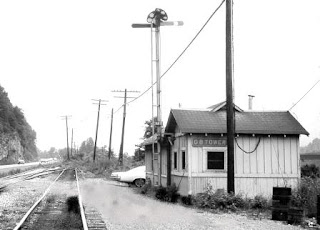
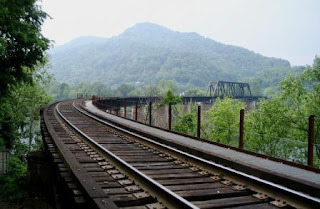
































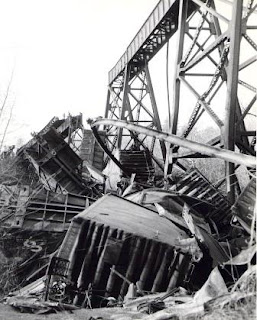















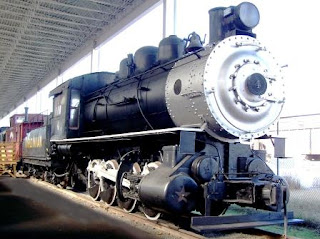



































trmimp%2Bsml.jpg)
